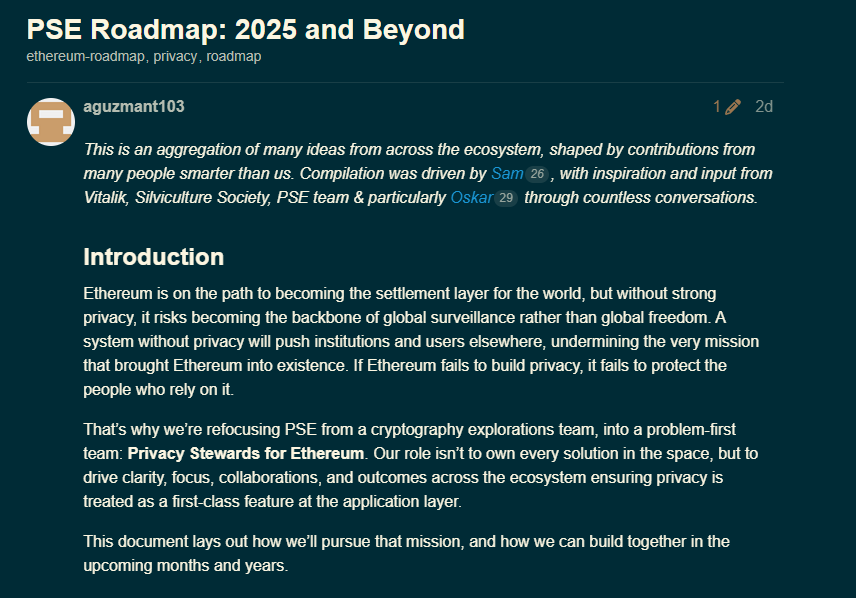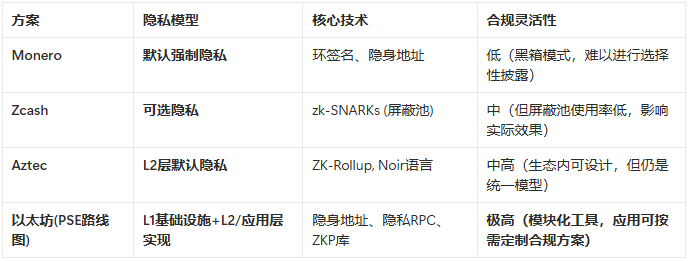Written by: Luke, Mars Finance
"If there is no strong privacy, Ethereum risks becoming a pillar of global surveillance rather than a pillar of global freedom." This is the warning written by the Ethereum privacy team in its latest roadmap. By 2025, when the legal battle over Tornado Cash is settled, the entire crypto world will realize: on the road to Web3, privacy can never become a "lawless land" in the fight against regulation.
The answer will be revealed on September 14, 2025. The "End-to-End Privacy Roadmap" released by the Ethereum Foundation is like a "trump card" played in the fog. The core of this card is not a return to the old path of anonymity, but the creation of an entirely new paradigm — "Compliant Privacy." This is not just a technical upgrade, but a profound strategic evolution by Ethereum in the post-Tornado Cash era, seeking mass adoption. This article will deeply analyze this roadmap and interpret how it cleverly balances both sides of the scale, paving a broader and more solid path for Ethereum's next decade.

From "Explorers" to "Stewards": A Responsibility-Driven Evolution
The release of the roadmap is accompanied by a key change: the former "Privacy and Scalability Exploration Team" has been renamed to "Ethereum Privacy Steward" (PSE). In today's increasingly clear regulatory environment, this renaming carries profound significance. "Explorers" can roam freely in uncharted territories, while "Stewards" must carefully manage the entire estate under existing rules. This marks a shift in Ethereum's privacy development from pure technical idealism to more responsible and pragmatic engineering practices.
As stated in its official charter, the team's mindset is shifting from "pursuing cool technology" to "solving specific problems," from "focusing on internal projects" to "driving ecosystem outcomes." This aligns with the viewpoint repeatedly emphasized by Ethereum founder Vitalik Buterin in recent years — privacy is an empowering technology, not a tool for confrontation.
Three Pillars of "Compliant Privacy"
The essence of this roadmap lies in the fact that it is not a single privacy protocol, but a systematic framework tailored for "Compliant Privacy," composed of "Private Writes," "Private Reads," and "Private Proving," with the ultimate vision of "making privacy on Ethereum the norm, not the exception."
1. Private Writes: Verifiable Anonymity
In traditional models, every on-chain transfer is like publicly shouting in a world square. The Stealth Addresses promoted by PSE aim to turn this shouting into delivering an encrypted private letter. But the key is that this letter is not untraceable. The holder of the letter, namely you, possesses the only key to decrypt and display the letter's content and flow path. This means that when necessary (for example, in the face of compliance reviews or audits), you can actively prove your transaction history to authorized parties without exposing it to the entire world. This is a form of "controllable anonymity," which is the foundation for achieving compliance.
2. Private Reads: Defending User Intent
Privacy is not only about transactions but also about intent. When you query on-chain data, RPC node service providers can easily spy on your actions, which is unacceptable in the financial world. The goal of Privacy RPC Services is to cut off this spying and protect users' fundamental digital rights. In a mature, regulated financial system, protecting customers' query intentions from misuse is a basic responsibility of infrastructure providers. This initiative aligns Ethereum's infrastructure with this standard.
3. Private Proving: The Magic of "Selective Disclosure"
This is the "trump card" within the "Compliant Privacy" framework. The true power of zero-knowledge proofs (ZKP) lies in achieving "selective disclosure." Imagine that in the future, you need to prove two things: (A) your funds do not come from sanctioned addresses; (B) your account balance exceeds 100 ETH to meet the entry requirements of a certain DeFi protocol.
With the help of ZKP, you can generate an encrypted proof that allows the protocol or regulators to verify that statements (A) and (B) are true, but throughout the process, they cannot see any of your specific transaction records or exact balance. PSE is committed to making this proof process cheap and fast, aiming to put this powerful compliance tool in the hands of every developer and user.
From Theory to Practice: Compliance Insights from Two Pioneer Projects
This blueprint is not just theoretical. The roadmap outlines a series of specific near-term initiatives, the most notable of which is the proactive embrace of institutional adoption.
PSE has explicitly stated that it will launch the "Institutional Privacy Task Force (IPTF)," collaborating with the Ethereum Foundation's enterprise team to directly clear obstacles to institutional adoption by establishing privacy standards and developing proofs of concept (PoC). This thoroughly confirms our article's argument for "Compliant Privacy" — Ethereum is actively taking the initiative to create the privacy solutions that Wall Street and global enterprises need.
At the same time, experimental projects like PlasmaFold have set clear goals to showcase their privacy transfer PoC at the upcoming Devconnect conference. To accelerate the development of the entire ecosystem, PSE will also collaborate with industry partners like Aztec to enhance the security and toolchain of the Noir language, ensuring that the next generation of privacy applications can safely flourish on Ethereum.
The Choice at the Crossroads: Why "Privacy Platforms" Are Superior to "Privacy Coins"?
The Tornado Cash incident has sounded the alarm for all native privacy coins. Their mandatory, integrated privacy models often lack flexibility in the face of regulation. Ethereum's new blueprint demonstrates a completely different wisdom.

Ethereum chooses to become a powerful "Privacy Empowerment Platform." It does not impose any specific privacy rules but provides underlying, Lego-like tools. This means that a DeFi project aimed at enterprise clients can use these tools to build a highly auditable privacy solution that meets KYC/AML requirements, while a dApp focused on social privacy can construct another solution that emphasizes anonymity. This flexibility is the optimal response to the complex and ever-changing global regulatory environment.
Conclusion: A Trump Card to the Mainstream World
In the post-Tornado Cash era, the crypto industry is forced to transition from the rebelliousness of adolescence to the prudence of adulthood. Ethereum's end-to-end privacy roadmap is a mature answer to this challenge. The "Compliant Privacy" trump card it reveals is not a short-term gimmick to stimulate the market, but a profound, long-term foundational restructuring.
This card allows Ethereum to break free from the binary opposition of "anonymity" and "transparency," paving a middle path toward mass adoption. It announces to Wall Street's financial giants, multinational corporations that value data sovereignty, and all ordinary users who look forward to a safer and freer digital future: a global settlement layer that embodies both the spirit of decentralization and the rules of the real world is becoming possible. This is not only Ethereum's winning strategy but perhaps also the necessary path for the entire Web3 to move toward the mainstream.
免责声明:本文章仅代表作者个人观点,不代表本平台的立场和观点。本文章仅供信息分享,不构成对任何人的任何投资建议。用户与作者之间的任何争议,与本平台无关。如网页中刊载的文章或图片涉及侵权,请提供相关的权利证明和身份证明发送邮件到support@aicoin.com,本平台相关工作人员将会进行核查。




